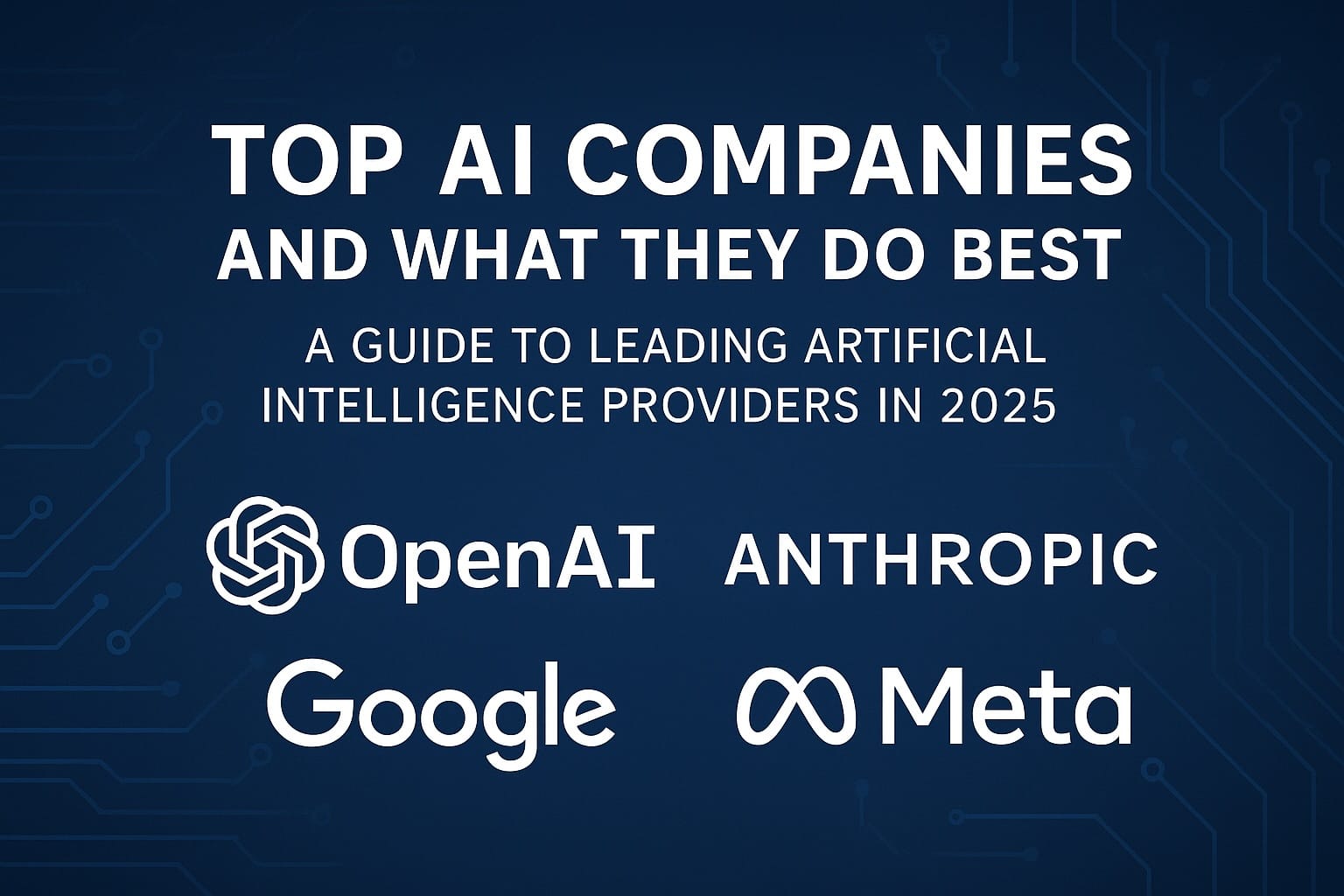Top AI Companies and What They Do Best: A Guide to Leading Artificial Intelligence Providers in 2025
The AI companies 2025 landscape is dominated by a mix of established tech giants and innovative startups, each carving out distinct specializations in the rapidly expanding artificial intelligence market. From NVIDIA’s dominance in AI infrastructure to OpenAI’s generative AI breakthroughs, understanding what AI companies do and their unique strengths is crucial for businesses looking to leverage artificial intelligence effectively.
Key Takeaways
- Market giants like NVIDIA, Microsoft, Google, and Amazon control different aspects of the AI ecosystem, from hardware to cloud services
- OpenAI leads the generative AI space with ChatGPT holding 60.5% of the US chatbot market share
- Specialized providers like Anthropic focus on AI safety while companies like CrowdStrike excel in AI-powered cybersecurity
- Enterprise solutions vary significantly, with platforms like Databricks serving data analytics and Palantir focusing on defense-grade applications
- Investment flows continue heavily into AI, with the global market reaching $638.23 billion in 2025 and projected to hit $3.68 trillion by 2034
The AI Revolution: Market Size and Leading Players
The artificial intelligence industry has reached unprecedented scale, with the global AI market valued at $638.23 billion in 2025. According to Precedence Research, this figure is projected to reach $3.68 trillion by 2034, representing a compound annual growth rate of 19.2%.
North America continues to dominate the AI landscape, with the US AI market alone worth $146.09 billion in 2025. This dominance stems from widespread industry adoption and the concentration of leading AI companies within American borders. The region’s advantage becomes even more apparent when examining the best AI models currently available in the market.
The competitive landscape reveals interesting patterns in consumer adoption. ChatGPT maintains a commanding lead with 60.5% of the US chatbot market share, followed by Microsoft Copilot at 14.3% and Google Gemini at 13.5%. However, growth rates tell a different story, with Claude AI showing the highest quarterly user growth at 14%, despite holding only 3.2% market share.
NVIDIA: The AI Infrastructure Powerhouse
When discussing the best artificial intelligence companies, NVIDIA stands out as the undisputed leader in AI compute infrastructure. The company controls over 80% of the global AI compute market and reported $94 billion in revenue in 2025, according to DesignRush.
NVIDIA’s dominance extends to the data center GPU segment, where it commands a 92% market share compared to competitors like AMD and Intel. This positioning makes NVIDIA the essential provider of GPU hardware for training advanced models like GPT-4, Gemini, and DeepMind’s various AI systems.
The company’s key products include:
– H100 and Blackwell GPUs for high-performance AI training
– CUDA software platform enabling parallel computing
– DGX systems for enterprise AI deployment
– Partnerships with major cloud providers for scalable AI infrastructure
NVIDIA’s strategic partnerships with major cloud providers have created a comprehensive ecosystem that supports the entire AI development pipeline. From startups training their first models to tech giants deploying consumer-facing AI applications, NVIDIA’s hardware forms the backbone of modern artificial intelligence.
Enterprise AI Giants: Microsoft, Amazon, and Google’s Cloud Dominance
The leading AI companies in the enterprise space represent a triumvirate of cloud computing giants, each bringing unique strengths to AI providers comparison discussions. Microsoft generates over $42 billion from AI-driven services, largely powered by its $13 billion partnership with OpenAI.
Microsoft’s AI strategy centers on integration across its enterprise software suite. Copilot, which holds 14.3% of the chatbot market share, seamlessly integrates with Office applications, Windows, and GitHub. Azure AI services provide businesses with direct access to OpenAI’s foundation models through the Azure OpenAI Service.
Amazon Web Services takes a different approach, focusing on democratizing AI development. With Amazon achieving $534 billion in total revenue in 2025, AWS powers AI for thousands of businesses worldwide. The company’s key offerings include:
– Amazon Bedrock for accessing foundation models
– SageMaker for building and deploying ML models
– Alexa for voice AI applications
– Advanced robotics and forecasting for logistics
Google represents the research-heavy approach to enterprise AI, investing $75 billion in AI development in 2025 plus an additional $1 billion into Anthropic. Google’s Gemini chatbot holds 13.5% market share with 8% quarterly user growth, while Vertex AI provides developers with comprehensive tools for AI application development.
OpenAI and the Generative AI Breakthrough
OpenAI stands as the poster child for generative AI success, nearing a $300 billion valuation as of February 2025 after raising $40 billion in primary investment. The company’s flagship product, ChatGPT, dominates the consumer AI space with 60.5% market share in the US chatbot market.
The company’s influence extends beyond consumer applications. OpenAI owns 9% of the foundation models and model management platforms market, making it a crucial player in the broader AI ecosystem. This position becomes more significant when examining the ongoing AI race among major technology companies.
OpenAI’s product portfolio demonstrates the breadth of generative AI applications:
– GPT-4 and ChatGPT for conversational AI
– DALL-E for image generation
– Whisper for speech recognition
– OpenAI API for developer integration
– Enterprise solutions for business deployment
The company’s push toward artificial general intelligence (AGI) sets it apart from competitors focused on specific use cases. This ambitious vision, combined with Microsoft’s distribution power, positions OpenAI as a central player in defining the future of AI technology.
Specialized AI Leaders: From Social Media to Cybersecurity
The top tech AI companies include several specialists that excel in specific domains rather than competing across all AI applications. Meta Platforms focuses on social media AI and open-source development, particularly through its Llama 3 models that compete directly with proprietary alternatives.
CrowdStrike represents the cybersecurity specialization, valued at $118 billion in 2025. The company’s Falcon platform uses AI and machine learning algorithms for real-time threat detection and prevention, serving Fortune 500 companies with autonomous protection capabilities that surpass traditional antivirus solutions.
Databricks exemplifies the data-centric approach to AI, emerging as the fastest-growing tech company with 60% year-over-year growth and over 10,000 enterprise customers. The company’s Lakehouse architecture bridges big data analytics and AI/ML, while Mosaic AI integrates multiple foundation models for enterprise deployment.
Industry-specific applications showcase the diversity of AI company specialties:
– Tesla’s end-to-end AI for autonomous vehicles and Dojo training chips
– Palantir’s defense-grade decision AI with Foundry and Gotham platforms
– C3.ai’s industrial AI for manufacturing, energy, and government applications
– UiPath’s robotic process automation for business workflow optimization
Emerging AI Innovators: Safety, Truth, and Enterprise Solutions
Anthropic has emerged as a significant player in the OpenAI vs Anthropic vs Google AI comparison, receiving a $1 billion investment from Google in early 2025. Claude 3, Anthropic’s flagship model, holds 3.2% of the US chatbot market but shows impressive 14% quarterly user growth.
The company’s Constitutional AI framework emphasizes safety and transparency in AI systems, attracting enterprise clients and regulatory attention. This focus on responsible AI development positions Anthropic as an alternative for businesses requiring explainable AI solutions.
xAI represents Elon Musk’s entry into the AI space, currently negotiating a $4.3 billion equity round with an $80 billion valuation. The company’s Grok-3 model integrates real-time social data from X (formerly Twitter), while the Colossus supercomputer provides massive computational resources for training and inference.
These emerging innovators bring unique approaches to common AI challenges:
– Anthropic’s emphasis on AI safety and constitutional principles
– xAI’s integration of real-time social media data
– Cohere’s developer-friendly natural language processing APIs
– Various hardware enablers like Broadcom, TSMC, and Intel supporting AI infrastructure
Best AI Tools by Company and Strategic Considerations
Choosing the right AI partner requires understanding each company’s strengths and limitations. The best AI tools by company vary significantly based on use case, scale requirements, and integration needs. For businesses comparing options, several factors emerge as critical decision points.
Revenue models and pricing structures differ substantially across providers. OpenAI’s API pricing favors experimentation and small-scale deployment, while enterprise platforms like Databricks and Palantir require significant upfront investment but offer comprehensive support and customization.
Market positioning reveals interesting competitive dynamics. While ChatGPT dominates consumer usage, enterprise adoption patterns show more diversity. Microsoft’s integration advantage, Google’s research capabilities, and Amazon’s infrastructure scale each appeal to different business requirements.
The AI industry leaders 2025 landscape continues evolving rapidly, with new entrants challenging established players. Recent developments, including the emergence of competitive alternatives, demonstrate that market leadership remains fluid and innovation-driven.
Strategic recommendations for businesses selecting AI providers should consider:
– Integration requirements with existing technology stacks
– Scalability needs and computational resource requirements
– Regulatory compliance and data governance standards
– Long-term partnership potential and vendor lock-in risks
– Specific use case alignment with provider specialties
The foundation models market continues consolidating around major players, but specialized applications offer opportunities for focused providers to establish strong competitive positions. Success in AI deployment often depends more on proper implementation and integration than on choosing the most prominent provider.
Sources
First Page Sage – Top Generative AI Chatbots
AI Magazine – Top 10 AI Companies
IoT Analytics – Leading Generative AI Companies
StartupBlink – Top AI Startups
Precedence Research – Artificial Intelligence Market
The Software Report – Top 25 AI Companies
latest video
news via inbox
Nulla turp dis cursus. Integer liberos euismod pretium faucibua





